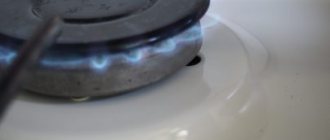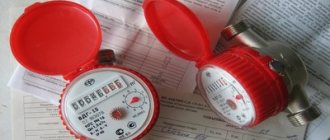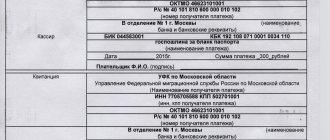Free legal consultation over the Internet 24 hoursLawyer on housing issues in St. Petersburg. Free legal consultation on labor disputes.
4.33/5 (18)
What is enshrined in law
Gas meters are measuring equipment that must be changed periodically to accurately measure the gas consumer.
After a certain time, metering devices begin to show incorrect values that do not correspond to the actual consumption of natural gas, both up and down.
Note! The gas meter, after its manufacture, is verified and sealed, after which it is ready for purchase by the user of the resource.
Federal Law “On Ensuring the Uniformity of Measurements” No. 102-FZ dated June 26, 2008 establishes the manufacturer’s obligation to carry out verification of manufactured metering devices, and the obligation to carry out verification after the expiration of the service life lies with the consumer, by the way, the obligation to change the gas metering device also lies with the consumer, who is the owner of the residential premises.
Is it necessary to install a gas meter?
The owner of a residential premises is obliged to equip his property with both general gas meters and individual ones, as well as to put them into operation.
This obligation is established by subclause 5 of clause 5.1 of Article 13 of the Federal Law “On Energy Saving and Increasing Energy Efficiency and on Amendments to Certain Legislative Acts of the Russian Federation” No. 261-FZ of November 23, 2009
Attention! Our qualified lawyers will assist you free of charge and around the clock on any issues. Find out more here.
Is it necessary to install a gas meter?
The transition of the Russian utility system to full accounting of consumed resources began about ten years ago as a result of the need to restore order in this area. Federal Law No. 261-FZ dated November 23, 2009 was developed and adopted, requiring owners of residential and commercial premises to equip their facilities with individual meters for metering resource consumption. The requirement also applied to household gas supply systems.
According to Federal Law 261, a deadline was set - January 1, 2021, after which all apartments and houses must be equipped with an IPU. Due to the occurrence of delays and various problems that increased the excitement around the installation of gas meters, Federal Law No. 269-FZ dated December 25, 2012 was adopted: the period for installing flow meters was extended for owners of residential premises. Each owner of a real estate property is required to equip the utility supply system with a metering mechanism before January 1, 2021.
There have also been innovations in other parts of the legislation. Starting in 2021, organizations involved in supplying gas to consumers have the right to compulsorily install meters in houses and apartments. Expenses are gradually recovered from the owner of the residential premises. The owner may interfere with installation or refuse to pay for the work, so sales companies are allowed to go to court.
Additionally, Decree of the Government of the Russian Federation dated May 6, 2011 No. 354 was adopted, which regulated and clarified the procedure for providing utility services to owners of private and apartment buildings. The PP justified the procedure for calculating payment, verification and the reasons why the gas flow meter may be declared unfit for use. We consolidated the installation and sealing process.
The responsibility for installing and maintaining the meter in operation lies with the owner of the residential premises, but in 2015, amendments to the legislation identified a category of citizens exempt from installing a gas meter. These are consumers in whose houses or apartments the maximum power consumption of the resource does not exceed 2 cubic meters per hour.
The rules most often apply to objects equipped only with a stove or when a stove is combined with a modern low-power column. The owners of these premises are not forced to switch to meters. Amendments do not apply if a gas boiler is installed.
How often is verification carried out according to the law?
The technical passport for a gas meter contains dates: the first is the date of manufacture of the meter, the second is the period of its guaranteed operation.
Not all metering devices have the same warranty period; depending on the meter model, the maximum service life reaches 25 years.
Metering devices also have a calibration interval - a period after which it is necessary to verify the meter readings.
Important! Most often, verification is carried out after 10 years, but there may be other deadlines. If, during verification of a metering device at the Standardization Center, it is discovered that it produces errors or incorrect indicators, it becomes necessary to replace the device with a new one.
In what cases is it necessary to change the device?
The following situations may be the reason for replacing the gas meter in 2021:
- the service life of the flow meter has expired;
- the verification period has expired;
- meter failure.
If the service life specified by the manufacturer has expired, then such a device is unsuitable for use and is not allowed to be used. This means that the gas meter needs to be changed. Depending on the type of meter used and its manufacturer, the service life ranges from 10 to 25 years.
These numbers must be looked for in the device passport.
If the established calibration interval has expired, then such a meter can either be sent for verification or simply replaced with a new one. The calibration interval for gas meters is usually from 5 to 12 years.
If the gas meter no longer takes into account gas consumption, the display has gone out, or there is a suspicion of incorrect operation, then the device can be either repaired or replaced. If the device was purchased recently, it is recommended to replace the meter under warranty.
The process of replacing the meter and the reasons that determine that the meter is not suitable for use are regulated by the laws of the Russian Federation, namely the Decree of the Government of the Russian Federation of September 19, 2013 N 824 On making changes.
What to do if the device breaks down
If the gas meter breaks down, you need to be guided by clause 28 of the Gas Supply Rules to ensure the household needs of citizens.
This paragraph says that in the event of a breakdown of the meter or loss of the seal, the resource must be calculated according to general standards from the moment the meter is notified of the breakdown until the time the problem is fixed.
If the gas meter breaks down, you must inform the gas service that the meter needs to be replaced.
If a breakdown of the metering device was discovered when gas service employees were performing a verification, the volume of resource consumed, according to general standards, is calculated from the day of the last verification to the day of sealing, but the maximum period is six months.
Who should install the meter?
Gas meters are installed only by licensed specialists.
Remember! In order to replace the meter, you need to:
- make an application to the gas service or MFC for replacement or verification of the meter;
- gas service employees initially check the condition of the gas pipeline, and then draw up an estimate of the costs of the work;
- The owner of the apartment independently purchases a gas meter.
Gas service employees install the meter and draw up a report on the work performed. Before this, the owner decides on the location where the gas meter will be installed.
Do not forget about the requirements for the location of the gas meter: the distance from the floor to the meter must be at least 1 meter 20 centimeters, and from the stove - no less than 80 centimeters.
Then you send an application to the management company to seal the meter. Sealing must be done no later than 3 days from the date of its installation.
Watch the video. At whose expense are the metering devices installed:
Instructions for filling out the act
- the name of the company in which the work was carried out. If this is a private person, it is enough to indicate passport details and the address where the home is located;
- information about the organization that replaced the device. Not only specific specialists are noted, but also information about the license is indicated, which gives the company the right to provide these services;
- the essence of the document. So you need to write that a gas meter was installed. The device number is indicated. The place and date of drawing up the act are indicated.
During the process of drawing up a document, the person in charge may accidentally make a mistake, for example, the device number is indicated incorrectly. This is a significant error that must be corrected using a specific algorithm. So, the number in which an error was made must be crossed out with one line. The correct option is indicated above or next to it. Then you need to find a free space in the margins or at the bottom of the document where you need to write “Corrected Believe.” In addition, these corrections must be certified by the signatures of responsible persons. Naturally, corrections are made in the presence of both parties.
At whose expense does the replacement take place?
Any metering device has its own service life. Work to replace a gas appliance must be carried out in accordance with the relevant rules.
Otherwise, the readings on this meter will be invalid, and the user will be forced to pay for gas consumption according to general standards, which are many times higher than actual consumption.
Attention! Gas supply lines are highly dangerous objects, and deficiencies in their installation can lead to serious consequences. Therefore, various legislative acts indicate the obligation to install a gas meter by licensed employees of certain services.
If this rule is violated, the user may receive penalties, because these actions are contrary to safety regulations.
Do not forget that the factory standards, which are specified in the passports of metering devices, indicate that the metering device should not be located at a distance closer than 2 meters from devices that emit moisture or heat (sink, radiator, etc.).
After the device is installed, it, as mentioned earlier, is sealed by the company servicing the housing (management company).
The need to replace a gas meter is determined by its breakdown or expiration of its service life (indicated in the technical passport). The gas meter is the property of the tenant, therefore responsibility for its replacement and condition lies on the tenant’s shoulders.
By order of State Standard No. 125, a citizen who owns a residential premises bears full responsibility for:
- for maintaining the metering device in working condition;
- for checking meters;
- for the correctness of the meter readings and its proper condition.
In other words, the owner of the residential premises is responsible for the serviceability of the metering device.
The procedure for replacing a gas meter in a private house
Any measuring equipment has an operational period. Replacement of the gas meter must be carried out according to established rules. Otherwise, his testimony will be considered invalid, and the person will have to pay according to the accepted average standards, and this is quite expensive. Next, we will talk about all the legal nuances.
Rules for replacing a gas meter
When installing gas meters in a private home, be sure to follow the following rules:
- Before installation, the specialist must make sure that the gas equipment is working properly and inspect the area.
- The minimum distance from the meter to gas equipment is 1 meter.
- The minimum distance from the opposite wall is 5 cm (this measure prevents corrosion).
- If the meter is installed outside, it must be placed in a metal cabinet or under a canopy.
- The room where the meter will be installed must have natural ventilation.
- The minimum distance from the floor is 160 cm. Some models may have their own requirements. In this case, they are guided by factory standards (usually indicated in the device passport).
- There should be no devices that generate moisture or heat (radiators, sinks, etc.) within 2 meters.
- After installation, the device must be sealed by an employee of the housing organization.
The need for replacement is determined by the serviceability of the device or the operating period (registered in the passport).
At whose expense is it produced?
The gas meter is the property of the owner of the house, so he is considered responsible for its condition.
According to Gosstandart order No. 125, the owner of the house bears full responsibility for:
- maintaining the meter in proper condition;
- verification of the device;
- the correctness of the device readings and its performance.
In other words, the property owner is obliged to ensure that the meter is in good condition. If necessary, he must carry out verification and subsequent replacement of the device at his own expense. This is stated in Article 158 of the RF Housing Code.
The only exception is municipal buildings - in them, replacement work is carried out at the expense of the state, that is, the local administration. On average across the country, the cost of replacing a meter is in the range of 3-4 thousand rubles.
List of required documents for filing an application
- passport of the owner of the house (in its absence, it is permissible to use another identification document);
- technical passport of the meter;
- documents confirming the rights to real estate (purchase/sale agreement, house register, etc.);
- if the applicant rents housing, then a rental agreement is provided;
- technical plan of the building;
- application (written in free form is acceptable);
- approved house gasification project.
Important: the application must indicate all the characteristics of the device (serial number, model, etc.). After the meter is replaced, to undergo the sealing procedure you will need to provide:
After the meter is replaced, to undergo the sealing procedure you will need to provide:
- technical passport of the new device;
- certificate of completion of installation work;
- a document confirming the commissioning of a new meter.
Procedure
Having prepared the list of documents, you need to do the following:
- Submit an application to a company that installs gas meters and conclude an agreement with it.
- After some time (the period depends on the workload of the company), a specialist will arrive to check the equipment and take the necessary measurements.
- After making preliminary calculations, the employee will announce the cost of the work. The service is usually paid for immediately (since you need to buy a meter).
- Then, on the appointed day, a specialist arrives and replaces the metering device. After this, you need to take from him all the necessary documents (certificate of installation work, contract and certificate of putting the device into operation).
- After which you need to contact the management company with an application and the necessary papers to seal the meter. This procedure is carried out within 3 working days. If the Criminal Code has violated the established deadlines, the citizen can file a complaint with the housing inspectorate.
Important! Such procedures should only be carried out by organizations with the appropriate license. Contacting a private specialist is unacceptable
Conclusion
Timely replacement of measuring instruments is primarily beneficial for the owner himself. If this is not done, utility bills will seriously increase, because in this case a person will have to pay according to average standards, and this, as a rule, is a costly undertaking.
How much does it cost to replace a device?
Calculation of the cost of replacing a metering device:
- cost of a gas meter;
- payment for the work of licensed employees (removal of a gas meter, installation of a jumper pipe);
- payment for services for verification and repair of metering devices;
- replacement of gas meter.
Important! Prices for services for replacing metering devices are determined by specialists on site. The price for each service depends on the complexity of its implementation, as well as the number of meters, the length of the pipeline for the output of the gas meter, as well as the region in which the residential premises are located, and the tariffs of the service company.
The approximate cost of a gas meter is 15,000 rubles, and the approximate cost of services for replacing a gas meter is about 7,000 rubles.
All expenses indicated above apply only to citizens who own apartments and private houses. If you live in council housing, all costs are borne by the municipality.
Verification or replacement - which is better?
When the deadline for verification of the metering device approaches, all work associated with the verification will be paid by the owner of the property.
Remember! It is not advisable for the homeowner to carry out verification for the following reasons:
- the price includes not only verification, but also work on dismantling, installing and sealing the metering device;
- delivery of the gas meter to the place of verification is carried out independently and at your own expense;
- if deficiencies are found during verification, then the meter must be replaced, and in this case the cost of verification is still payable;
- verification work can last up to three weeks, and during this time the owner pays for gas according to the standard.
Therefore, some owners believe that at the end of the verification period it is better to completely replace the gas meter. As already mentioned, the verification interval depends on the brand and type of metering devices; it can range from 5 years to 12 years.
What installation rules must be followed?
Remember that the meter must be installed in accordance with the rules:
- the distance from the floor to the meter must be at least 1 meter 20 centimeters. The device must be installed no further than 80 centimeters from the stove or other gas appliance;
- the gas meter should not be above the stove, but to the side of it. The gas meter is attached by welding or a rubber sleeve, which should not be exposed to heat;
- the device can be located both in a vertical and horizontal position;
- The installation location of the metering device should be convenient for taking readings, maintenance and repair. You can place it next to the entrance for ease of checking readings, but taking into account all the above requirements.
Rules for placing household gas meters
The issue of placement of household meters is especially relevant at this time due to the fact that standards for the installation of gas meters create a lot of problems when planning a kitchen. According to SNiP SP 42-101-2003: The distance from the installation sites of meters to gas equipment is taken in accordance with the requirements and recommendations of manufacturers set out in the meter passports.
If there is no such data in the passport, then the distance to the slab is at least 0.8 m. Vertical - 1.6 m from the floor. This requirement spoils the entire interior of the kitchen. Many modern counters have placement requirements specified in their passports, because... for example, to install a Grand-4 meter, it is enough to step back only 5 cm from the stove. In cases where the distance from the installation sites of meters to gas equipment is not stated in the meter passports, then you will have to comply with the requirements of SNiP. Let's look at the rules for placing household meters.
To quantitatively record the gas mixture passing through a certain section of the pipeline per unit of time, special gas metering devices are used at the household level - gas meters. Installation of meters is provided based on the conditions of ease of installation, maintenance and repair. The installation height of meters, as a rule, should be 1.6 m from the floor level of the room or ground.
In order to avoid corrosion damage to the meter's coating, when installing it, a gap (2 - 5 cm) should be provided between the meter and the structure of the building (structure) or support.
Installation of the meter indoors is provided outside the zone of heat and moisture release (from a stove, sink, etc.) in naturally ventilated places. It is not recommended to install meters in stagnant areas of the room (areas of the room fenced off from the ventilation duct or window, niches, etc.).
In the absence of the above requirements in the passports, the placement of meters should, as a rule, be provided at a distance (radius) of at least:
– 0.8 m from a household gas stove and gas-using heating equipment (capacitive and instantaneous water heaters, boilers, heat generators);
– 1.0 m from a restaurant stove, cooking boiler, heating and heating-cooking oven.
External (outside the building) installation of the meter is provided under a canopy, in cabinets or other structures that protect the meter from external influences. Open installation of the meter is allowed.
The placement of the meter includes:
– on a separate support on the territory of the gas consumer;
– on the wall of a building being gasified at a horizontal distance of at least 0.5 m from door and window openings.
Placing meters under openings in walls is not recommended.
The design of the cabinet for placing the meter must provide natural ventilation. Cabinet doors must have locks.











